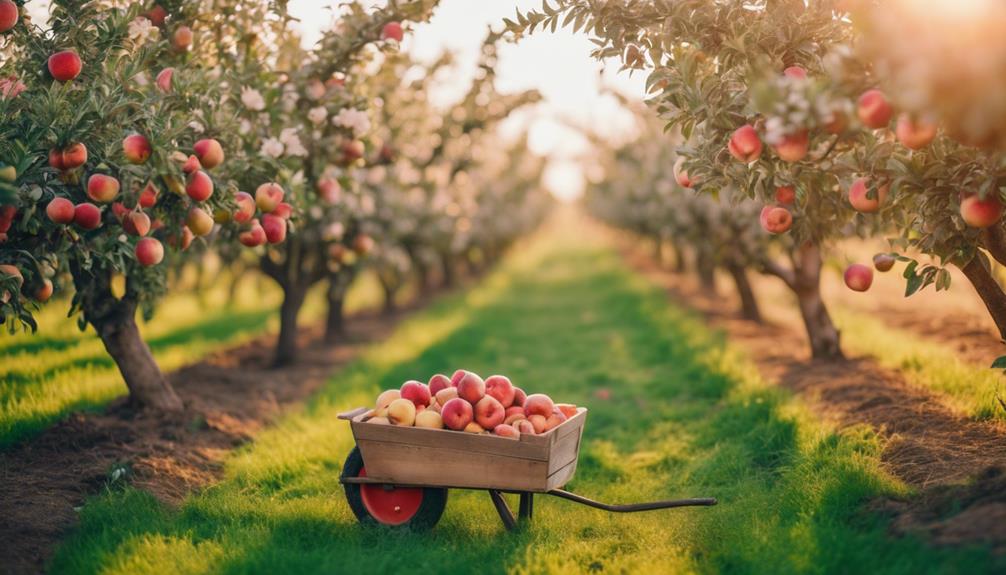To kickstart your dream fruit orchard, start by selecting the right location. Your site should receive at least six hours of sunlight daily and have well-drained soil to prevent root rot. Proper spacing between trees enhances growth and air circulation. Next, choose the best planting techniques, guaranteeing the root collar is just beneath the soil surface. Monitor harvest times by checking the fruit's color and taste for ideal quality. Finally, confirm effective pollination by planting compatible varieties nearby to attract beneficial pollinators. Tuning into these vital steps will set you on the path to success, revealing more strategies and insights along the way. For additional guidance, consider consulting expert resources and connecting with local agricultural extension services for further advice and support. These valuable sources can provide additional tips and best practices to help you cultivate a thriving orchard. In the same way that a farmer needs to have the essential patriotic reading list, a fruit orchard grower needs to have the essential tools and knowledge to succeed in their venture. By staying informed and seeking out valuable resources, you can ensure the success and productivity of your orchard for years to come.
Key Takeaways
- Choose a sunny location with well-drained soil to ensure optimal growth for your fruit trees.
- Stratify seeds to improve germination, simulating winter conditions before planting.
- Space trees adequately to reduce shading and enhance air circulation for healthy growth.
- Monitor fruit color, size, and taste to determine the ideal harvest time for each variety.
Choosing the Right Location
Selecting the ideal location for a fruit orchard is vital, as it must consistently receive at least six hours of sunlight each day to promote healthy tree growth.
Additionally, well-drained soil is important to prevent root rot and guarantee maximum nutrient absorption.
The spacing between trees should be adequate to allow for their mature size, reducing the risk of shading and enabling proper air circulation.
Morning shade followed by full sunlight can enhance growth, particularly in warmer climates.
In some cases, removing surrounding trees may be necessary to maximize sunlight exposure.
A thorough site assessment, considering factors such as drainage, sunlight, and space, will ultimately contribute to a thriving fruit orchard and successful harvests.
Growing Trees From Seeds
Initiating the growth of fruit trees from seeds requires careful attention to the stratification process, which mimics natural winter conditions to enhance seed germination.
This can be achieved by either planting seeds outdoors during winter or placing them in a bag with moist potting soil inside a refrigerator for four to six weeks.
Proper moisture control is essential, as excessive saturation can damage the seeds.
Once the stratification is complete, you will have viable seedlings ready for planting.
Be sure to mark the location of the seeds if planted outdoors to avoid misplacement.
With successful stratification, you lay the foundation for a thriving fruit orchard, enabling a diverse selection of fruits to flourish in your garden.
Planting Techniques for Success

Effective planting techniques are essential for ensuring the successful establishment and growth of fruit trees in an orchard.
Begin by selecting a suitable location with ample sunlight and well-drained soil.
When planting, dig a hole that is twice the size of the root ball to facilitate proper root expansion.
Position the tree so that the root collar is just beneath the soil surface, providing stability and preventing rot.
Refill the hole with the original soil to support the tree's foundation.
It is vital to water the newly planted tree thoroughly, ensuring moisture without over-saturation.
In certain cases, staking the tree can aid in maintaining an upright posture during initial growth.
These techniques lay the groundwork for a thriving fruit orchard.
Understanding Harvest Times
Understanding the ideal harvest times for various fruit trees is essential for maximizing flavor and ensuring the best quality of produce.
Fruits ripen at different intervals, necessitating careful monitoring of their color, size, and taste to determine readiness.
It is important to recognize that different varieties may have early, mid, or late harvest seasons, allowing for staggered ripening and an extended enjoyment of fruits.
For instance, apples and pears typically have a longer shelf life compared to more perishable options like cherries and plums.
Properly timing your harvest can also facilitate fresh consumption or preservation methods, preventing spoilage and ensuring that your orchard yields the best possible fruit quality throughout the growing season.
Ensuring Proper Pollination

Pollination plays an essential role in the successful production of fruit, as it facilitates the transfer of pollen necessary for fertilization and fruit set.
Many fruit trees, such as apples and pears, rely on cross-pollination to produce a bountiful harvest, while others can self-pollinate.
To guarantee proper pollination, it is vital to plant compatible varieties within proximity, as this increases the likelihood of successful pollen transfer.
Additionally, attracting pollinators like bees and butterflies can greatly enhance pollination efficiency.
Maintaining a diverse garden ecosystem with flowering plants can support these beneficial insects.
Consulting local nurseries for specific pollination requirements is also advisable, helping you make informed decisions when selecting tree varieties for your orchard's success.
Frequently Asked Questions
What Are the Best Fruit Tree Varieties for Beginners?
For beginners, apple, pear, and cherry trees are excellent choices due to their adaptability and relatively low maintenance. Additionally, consider dwarf varieties for smaller spaces, ensuring they receive adequate sunlight and proper care for ideal growth.
How Long Does It Take for Fruit Trees to Bear Fruit?
The anticipation of waiting for fruit trees to bear fruit can feel like an eternity. Typically, trees may take three to five years to produce fruit, depending on the variety and growing conditions, rewarding patience with delicious harvests.
Can I Grow Fruit Trees in Containers?
Yes, fruit trees can be successfully grown in containers. However, selecting dwarf or semi-dwarf varieties, ensuring adequate drainage, and providing sufficient sunlight and nutrients are essential to promote healthy growth and fruit production.
What Pests Should I Watch Out for in My Orchard?
In an orchard, pests are shadows that threaten vibrant fruit. Watch for aphids, spider mites, and fruit flies, as these invaders can devastate your harvest. Regular monitoring and integrated pest management are essential for safeguarding your trees.
How Often Should I Fertilize My Fruit Trees?
Fertilizing fruit trees typically occurs annually in early spring, aligning with growth resumption. However, specific needs may vary based on tree species, soil health, and growth stage, necessitating regular soil testing for ideal nutrient management.
Conclusion
Establishing a fruit orchard is akin to nurturing a symphony; each tree represents a different instrument, contributing to a harmonious yield of delicious produce.
Just as a skilled conductor guarantees that every musician plays in sync, careful attention to location, planting techniques, and pollination requirements creates a flourishing ecosystem.
By committing to these foundational practices, aspiring orchardists can cultivate a sustainable source of nourishment, ultimately reaping the rewards of their labor in the form of vibrant, homegrown fruits.










